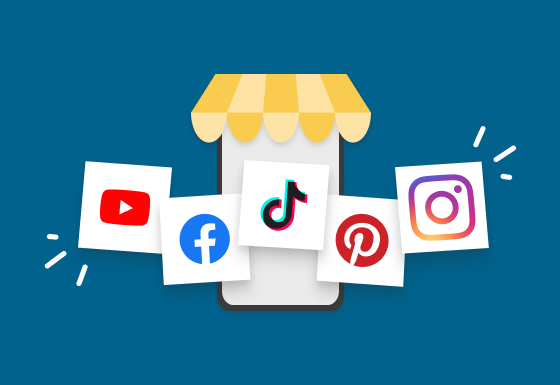In the ever – evolving world of retail, social commerce has emerged as a significant force. Two platforms, Instagram and TikTok, are at the forefront of this change, revolutionizing the way businesses sell and consumers shop. Let’s explore how these platforms are transforming the retail landscape.

I. The Basics of Social Commerce
A. What is Social Commerce?
- Blending Social Media and E – commerce
Social commerce combines the power of social media with e – commerce. It allows businesses to sell products directly through social media platforms. For example, instead of just promoting a product, companies can now include a “buy now” button on their social media posts. This makes it easier for consumers to make a purchase right away, without having to visit a separate website. - The Role of User Engagement
User engagement is key in social commerce. Consumers can like, comment, and share product posts. This not only spreads the word about the product but also builds a sense of community around the brand. For instance, a customer’s positive review or recommendation can influence others to make a purchase.
B. The Popularity of Social Commerce
- Changing Consumer Behavior
Consumers today are more active on social media than ever. They spend a significant amount of time scrolling through their feeds. Social commerce takes advantage of this by presenting products in a more engaging and accessible way. For example, a young fashion – conscious consumer might discover a new clothing brand while browsing Instagram and decide to make a purchase immediately. - Increased Accessibility for Businesses
Social commerce has made it easier for businesses, especially small and medium – sized enterprises, to reach a wider audience. They don’t need a large marketing budget to promote their products. Platforms like Instagram and TikTok offer various tools and features that allow businesses to showcase their products effectively.
II. How Instagram is Changing Retail
A. Instagram Shopping Features
- Shoppable Posts
Instagram’s shoppable posts are a game – changer. These posts allow users to tap on a product in an image or video and get more information about it, including the price and where to buy. For example, a beauty brand can post a photo of its new lipstick collection, and users can click on the lipstick they like to purchase it directly. - Instagram Reels and Shopping
Instagram Reels has also become a powerful tool for retail. Brands can create short, engaging videos to showcase their products. They can add links to the products in the Reels, making it easy for users to buy. For instance, a home decor brand can create a Reel showing how to decorate a living room with its products and include a link to buy those items.
B. Influencer Marketing on Instagram
- Collaborations with Influencers
Many brands collaborate with Instagram influencers to promote their products. Influencers have a loyal following, and their recommendations can have a significant impact on consumer purchasing decisions. For example, a fitness influencer might promote a new line of workout clothes, and their followers are likely to consider buying those products. - Measuring the Impact of Influencer Marketing
Instagram provides tools to measure the impact of influencer marketing campaigns. Brands can track how many clicks, likes, and purchases are generated from an influencer’s post. This helps them to evaluate the effectiveness of their campaigns and make better decisions in the future.

III. How TikTok is Changing Retail
A. TikTok Shopping Features
- In – app Shopping
TikTok has introduced in – app shopping features. Users can now shop directly within the app. Brands can create product listings, and users can browse and purchase products without leaving TikTok. For example, a tech brand can list its latest gadgets on TikTok, and users can buy them with just a few taps. - TikTok Live Shopping
TikTok Live Shopping is another popular feature. Brands can host live streams to showcase their products, answer questions from viewers, and encourage them to make a purchase. For instance, a fashion brand can hold a live stream to show its new collection, and viewers can buy the clothes they see in real – time.
B. Viral Marketing on TikTok
- The Power of Trends
TikTok is known for its viral trends. When a product becomes part of a trend, it can quickly gain popularity. For example, a certain type of makeup product might become popular through a TikTok trend, and many users will want to buy it. Brands can take advantage of these trends to promote their products. - User – generated Content
User – generated content is highly influential on TikTok. When users create content featuring a product, it can go viral and reach a large audience. Brands can encourage user – generated content by running contests or challenges. For example, a food brand can run a challenge asking users to create recipes using its products, which can lead to increased brand awareness and sales.
IV. Challenges and Opportunities in Social Commerce
A. Challenges
- Competition
With the rise of social commerce, the competition has become fierce. Many brands are vying for consumers’ attention on platforms like Instagram and TikTok. This means that brands need to be more creative and strategic in their marketing efforts to stand out. - Trust and Security
Consumers are concerned about trust and security when shopping on social media. They want to ensure that their personal and financial information is safe. Brands need to build trust with their customers by providing secure payment options and protecting their data.
B. Opportunities
- Global Reach
Social commerce offers a global reach. Brands can sell their products to consumers all over the world. For example, a small local handicraft brand can reach international customers through Instagram and TikTok, expanding its market significantly. - Data Analytics
Platforms like Instagram and TikTok provide valuable data analytics. Brands can use this data to understand their customers better, such as their preferences, behavior, and demographics. This information can be used to create more targeted marketing campaigns and improve the overall shopping experience.

In conclusion, Instagram and TikTok are playing a crucial role in the rise of social commerce and changing the retail industry. While there are challenges, the opportunities they present are vast. As these platforms continue to evolve, businesses need to adapt and make the most of these changes to stay competitive in the retail market.





